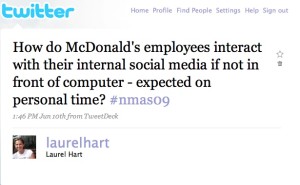Teachable moments in communication arrive in many forms.
Take 2 minutes and 8 seconds to witness an act of elegance and meaning.
Start Asking from Ryan Fitzgibbon on Vimeo.
Ryan Fitzgibbon designed the video you just watched to comment on the United States’ progress on civil rights. I found it during some random Twitter-surfing, and when I first saw it, I said, “Wow! This really speaks to me.” Here’s what resonated: Fitzgibbon took the opportunity to be a provocateur, but in the best way possible. His language and images are spare, but he moves through the difficult issue of prejudice with great sensitivity and impact.
The video succeeds for me because its creator employs most of what I will call the 10 Rules of Communication Elegance:
Rule 1. Aim for elegance. Before you even begin to share your ideas, unpack half of that suitcase of information you’ve brought for the occasion. Make better use of your nucleus of ideas by stripping them down to basics. Yes, simplicity is a baseline requirement for communication. But elegance is even more focused and strategic: it informs simplicity. It not only transmits, it inspires. Keep reading, and I’ll tell you how.
Application: Fitzgibbon packs so much punch in a very short period of time – about the length of a television commercial break. There is no excess information. He pushes us to begin being more tolerant today just by questioning ourselves. He doesn’t download all his knowledge about prejudice and discrimination. He just gives us the stripped-down essentials for immediate action. I found myself asking the questions the video presented.
Rule 2. Punctuate your communications with meaning. Inspiration doesn’t automatically follow the expression of ideas. Inspire others with an act of meaning. That’s how I’m defining elegance: it is simplicity plus meaning. Minds differ on what meaning is, but, for me, it’s working toward a shared good. It’s sharing what I have and what I know to help empower others.
Application: Eliminating prejudice and discrimination is an undeniable collective good. In his video, Fitzgibbon draws us in with an urgent problem and then gives us an immediate tool to deal with it. That call to action is meaningful and gives his communication resonance.
Rule 3. Lead with the dynamic duo–your energy and emotion. The duo also goes by the name passion, and the literature on leadership and public speaking overflows with discussions about it. But the truth remains: With passion, you will connect to others. It is perfectly fine to communicate with structure, strategy and intentionality, but let your energy and emotion seek some entropy, and others will want to follow right along with you.
Application: This video bristles with emotion. All the usual visual clutter of life has been removed, and we are only able to zoom in on the closed eyes and facial expressions of the people we see. The unsteady camera seems to twitch along with the muscles of the narrators. We may not see into their souls, but we hear the emotion in their voices, we feel the clinched discomfort in their body language, and we sense the urgency of what they are asking. That urgency is contagious.
Rule 4. Develop an authentic point of view and express it in your own way and on your own terms. Your authenticity will influence others to be led by you. Don’t try to be a cover version of someone else. Discussions of authenticity also abound in the literature. Never mind that. Being authentic means being natural, having integrity and always striving to express your best self. It is a fundamental building block of credibility.
Application: Fitzgibbons allows the authenticity of the people in his video to speak directly to us. Through their words and body language, we begin to understand the pain of exclusion and misunderstanding. We believe them.
Rule 5. Mix in some surprise. Surprise scrambles the brain’s thought sequencers temporarily and then facilitates a higher level of learning. It forces people to think of something in a different way. Use some surprise at the beginning of your narrative, and the results may surprise you.
Application: Fitzgibbon’s video does the unexpected. It does not pontificate on a subject that has inspired much pontification. There is no lecture on prejudice before the call to action. There is merely a stream of thought-provoking questions. While they may not be entirely surprising, they are certainly disarming. Fitzgibbon also orchestrates a sense of mystery. Throughout the video, we wonder what our questioners will do next. We wonder when they will open their eyes. What will the great reveal be? Will our eyes open along with theirs?
Rule 6. Add visuals. They provide a concrete picture to which people can relate. They point to a specific example. And images drive learning.
Application: Do we really need to discuss this one? The video has impact because of its spare and stunning visuals.
Rule 7. Tell a story. By all means, make it personal. Real-life vignettes or detailed case studies take statements out of the abstract and ground them with concreteness. Never underestimate the power of storytelling.
Application: Fitzgibbons shows us that meaningful stories don’t have to be long. They just have to be personally compelling.
Rule 8. Signal your critical points of information with numbers. Think “three key takeaways,” “Seven Habits of Highly Effective People,” and “5 Ways Social Media Can Drive More People to Your Website.” These countable items provide your listeners and viewers with a road map for what comes next. They’ll want to go with you if you let them know where they are going.
Application: So, we see our filmmaker didn’t use this one. Well, I did say he used most of the rules.
Rule 9. Repeat your critical points with nuance. Repetition drives learning, but rote iteration isn’t what I mean. Don’t just repeat. Build on the points you’ve already made. When revisiting key ideas, be sure to add texture, shading andnuance.
Application: Fitzgibbon builds his entire video by repeating his theme. With each new person we see we get a new frame of reference. We are able to see how prejudice is personal in different ways for different people.
Rule 10. The rules provide valuable fundamentals but they do not guarantee success. Applying the rules will make you a good technician. Using them will make you more persuasive. But, you can only become an artisan by repeatedly putting them into practice. Never leave homebase without Rules 1 through 4. And, then, learning how to use Rules 5 through 9 judiciously will take you farther along the path of becoming an elegant communicator.
Application: Obviously, Fitzgibbons has practiced his craft. We thank him for being so elegant in this teachable moment.
Click here for more info about Ryan Fitzgibbon and the making of the video.







